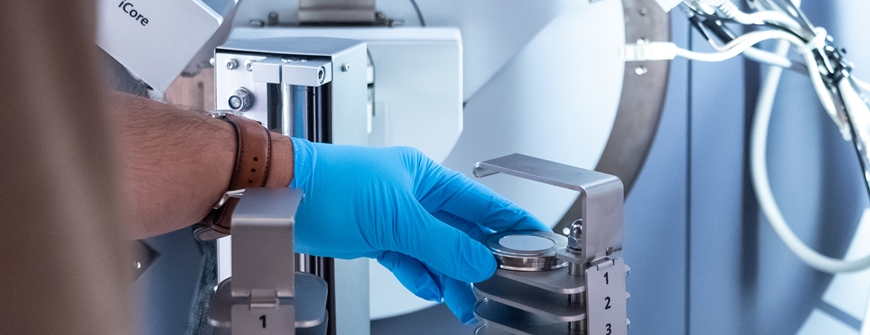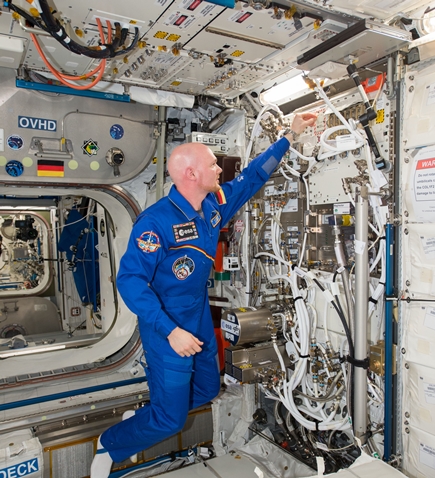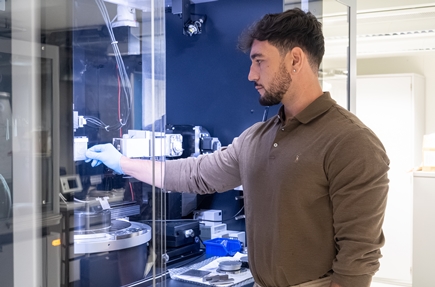Metallic glasses
Empa experiments aboard the ISS
Metallic glasses are novel materials with applications in space technology, but also in medicine and the watch industry. To better understand their properties and improve their production, Empa researchers are conducting various experiments on board the International Space Station (ISS) in collaboration with the European Space Agency (ESA).

Metals are versatile materials that surround us everywhere, whether as large structural elements or tiny components in our electronic devices, as robust tools or elegant jewelry. In most applications, they show an ordered crystalline structure, which they almost always adopt when solidifying from the melt. But what happens when metal atoms do not arrange themselves in clear patterns? If certain alloys are cooled very quickly, they solidify into a “disordered” – amorphous – structure similar to that of glass. This is why such amorphous metals are also referred to as “metallic glasses”.
Metallic glasses are something like the Holy Grail of metallurgy. They are as hard as quartz glass and their smooth surface is particularly resistant to scratches and corrosion. Unlike glass, however, metallic glasses are elastic and return to their original shape after deformation more readily than ordinary metals. This makes them a sought-after material for applications in medicine and space technology.
The crux of the matter, however, is the production of metallic glasses, because most metals are “eager” to assume their natural crystalline form. “It is particularly difficult to maintain the amorphous structure when manufacturing larger components,” says Empa researcher Damien Terebenec, who conducts research on metallic glasses at Empa's Center for X-ray Analytics.
Eliminating gravity

Materials scientists such as Terebenec work with complex alloys and precise processes to produce amorphous metals. This requires a thorough understanding of the physical properties of the material, especially in its molten liquid form. This presents a challenge: “The metallic liquid droplet must be levitated to avoid crystallization induced by contact with the crucible, which could otherwise compromise the entire experiment” explains Terebenec. To this aim, strong electromagnetic fields can be used to levitate droplets of liquid metal in suspension – but the gravity of the Earth deforms the spherical droplets and distorts the measurements.
For this reason, Terebenec and other researchers at the Center for X-ray Analytics, headed by Antonia Neels, are using a unique research platform: the International Space Station (ISS). As part of the European Space Agency's (ESA) THERMOPROP research project, led by Neels, the researchers are investigating the physical properties of metallic glasses in microgravity – the near-weightlessness of Earth's low orbit. At the same time, experiments are also being conducted at Empa in Dübendorf, where Neels, Terebenec, and their colleagues are characterizing the structure of metallic glasses using various X-ray techniques.
“The data from the experiments on the ISS is fed into materials simulations, which in turn can be used to develop and optimize industrial processes,” says Antonia Neels. Despite the lofty heights at which some of the experiments are taking place, the project is grounded in practice: Besides researchers from Empa and EPFL, an industrial partner has been involved from the outset. The Swiss company PX Group from La Chaux-de-Fonds manufactures metallic glasses for the watch industry, where the hard, flexible materials are used for precise mechanisms and robust cases. “Our partner has already been able to incorporate our findings from the project into improved manufacturing processes,” says Neels.
Reliable mechanisms for satellites

The knowledge gained on board the ISS and at Empa is also being fed back into space. In addition to their terrestrial applications, metallic glasses are well-suited for use in spacecrafts and satellites. Their elasticity and resistance enable the construction of reliable mechanisms that function maintenance-free over long periods of time. In a second project with ESA, Empa researchers are exposing samples of the material to the harsh conditions of space.
The corresponding experiment, called SESAME, flew to the ISS in November 2024 and was installed on the outside of the European laboratory module Columbus in December. It comprises numerous material samples from 15 European research institutions. After about a year in space, the samples will return to Earth and be analyzed – including the metallic glass provided by Empa researchers. “We can simulate individual space conditions on Earth, such as temperature fluctuations, vacuum, or radiation – but not all of them together,” explains Neels. “We want to know whether a prolonged exposure to space conditions changes the structure of the material, because in the end, the structure defines the properties” adds Terebenec.
The experiments on the space station are not one-offs but are carried out in batches. Further experiments with Empa's liquid metallic glasses on board the ISS are scheduled to take place next year. “Both projects will probably run until the end of the ISS in 2030,” says Neels. There is still a lot to learn in and for space.
Prof. Dr. Antonia Neels
Empa, Center for X-ray Analytics
Phone +41 58 765 45 07
Dr. Damien Terebenec
Empa, Center for X-ray Analytics
Phone +41 58 765 41 38
SLJ Thomä, R Zboray, A Chevalier, R Frison, R Sauget, S Prades-Rödel, R Logé, A Blatter, A Dommann, A Neels: Partial crystallization in Pd-BMG systems: From understanding structure towards influencing functionality through temperature-time series; Journal of Materials Research and Technology (2024); doi: 10.1016/j.jmrt.2024.10.236
F Haag, R Sauget, G Kurtuldu, S Prades-Rödel, JEK Schawe, A Blatter, JF Löffler: Assessing Continuous Casting of Precious Bulk Metallic Glasses; Journal of Non-Crystalline Solids (2019); doi: 10.1016/j.jnoncrysol.2018.09.035
Space technologies
Empa's research is conquering space. From components for space probes and imaging techniques for satellites to materials development on the International Space Station: Empa researchers are working on a wide range of materials and technologies for use at the “final frontier”. But no matter how high the research flies, it is still down-to-earth, as technologies for space have a variety of applications on Earth, whether for innovative electronics, medical devices, or monitoring environmental agreements.
Read the EmpaQuarterly online or download the PDF version.
-
Share






